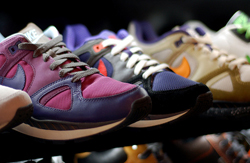The other day I accompanied my daughter to the mall to buy a pair of sneakers. This may sound like an ordinary errand. Not for me. As devoted as I am to shoes (the subject for another column), I haven’t worn a pair of sneakers since the twelfth grade. The reason is simple: I don’t have “sneaker legs” — those long, skinny appendages that can carry off sneakers (i.e., not make their possessor look like a flat-footed troll). I wear espadrilles to the gym (OK, Curves), and even my bedroom slippers have 2-inch wedges.
In short, the trip to buy sneakers was not for myself but for my teenage daughter. I tagged along for bonding purposes and vicarious pleasure. My daughter is one of those carefree, athletic girls who has sneaker legs. One of the joys of parenthood is to see one’s progeny carry off things you couldn’t.
So there I was in the mall, confronted by the sneaker store. I had noted it before in passing (how could one miss it, it took up practically one side of the mall?), but I hadn’t ventured inside. I was surprised when I did.
The store bore no resemblance to the modest shoe store of my youth where I used to buy sneakers for high school gym. That store was a drab establishment, presided over by middle-aged men with combovers, whose fingers had grown calloused from lacing and unlacing shoes. This store, by contrast, was a festive, brightly painted space overseen by cool young people with striped blouses and whistles. There were plushly upholstered banquettes and racks of chic athletic garb — shorts, tops, socks, and other sneaker accessories, not to mention the sneakers themselves — a vast collage of specimens. They were displayed on little platforms, delicately suspended on the walls from floor to ceiling.
My daughter began to survey the sneakers. I looked, too. Among the models on display were a few that faintly resembled the sneaker of my youth — that little white canvas shoe with rubber sole that I used to cram into my locker with my cobalt-blue snap gymsuit. I can still bring to mind the commingling odor of rubber and sweat from that locker, and its evocation of Miss Greeny, my high school gym teacher, a woman of practiced sadism. Such gym teachers, I’m told, no longer exist, and I harbor a certain nostalgia for them, if only because they recall a time before sneakers came to dominate the footwear landscape.
But to return to the subject. Most of the sneakers on display in the sneaker store were nothing like the modest sneakers of my youth. They were instead dazzling deviations, extravagant spin-offs. There were sneakers with plastic inserts and flashing lights, sneakers with retractable wheels, sneakers with mesh and nylon overlays, sneakers with oversized tongues and flaps and with complicated lace and Velcro fastenings.
My daughter seemed to understand the sneakers — to speak their language. Some she rejected summarily because the stripes were in the wrong direction or the colors were off (pink, in a neat reverse stroke, apparently verboten for girls). Some she dismissed as cool but not for her (though just right, perhaps, for an extraterrestrial court jester).
Finally, she conferred with the gum-chewing salesgirl about a model with a plastic and rubber sole evocative of a tractor. She wanted it in gray and blue and not in gray and green. The salesgirl seemed sympathetic. She understood. But no gray and blue was to be had. Other options were presented, considered.
How could there be so many sneakers? To me, they all looked pretty much alike, and, to be honest, they all looked ugly. I told my daughter this, and she replied that I simply wasn’t looking at them correctly. You had to consider the colors and the textures; the shape of the toe and the elevation of the heel; whether or not everyone had them — you didn’t want what everyone had, though you didn’t want what no one had either. Not to mention whether or not the sneakers looked good with your jeans (an entire subcategory dependent on whether you favored boot leg or flared).
Then it dawned on me: The sneakers were art. Either you had the vocabulary to understand them or you didn’t. They all looked alike to me, but I was untutored in sneaker esthetics, ignorant of the various schools of sneaker representation. Repetition is basic to any genre; it encourages the exercise of discrimination based on small deviations. Think of Warhol’s repetitive prints or Monet’s waterlilies.
Obviously, the other young women gazing at the wall understood. So did the gum-chewing salesgirl who finally brought out a pair — gray and orange, not gray and blue, but for some reason exactly right. Only a glance was enough for my daughter to know. No question; this was the pair.
And so we left the sneaker museum or, given the commercial element, the sneaker gallery. The gum-chewing curator, responsible for excavating the gray and orange model out of inventory, waved goodbye. My daughter, the discriminating collector, seemed pleased. The remaining patrons, harried mothers in tow, continued to survey the pieces on display, looking for what would fit the right niche in their personal collections.
I’m sharing this metaphor in the hope that it will help others as it helped me. To think of a sneaker as art soothes the pain of shelling out $84.99 for it. $84.99 is a good price. I’ve been in galleries where you couldn’t get away with spending less than $2000. • 27 November 2007




